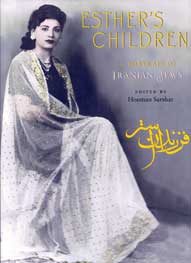The Graduate Society Foundation Daneshvaran
Esther's
Children
About the Book
 This magnificent volume makes available for the first time
a comprehensive history of the Jews of Iran from their earliest
documented settlement in 722 B.C.E. (2 Kings 18:9-19) through
to the end of the twentieth century. Lavishly illustrated in
full color with more than five hundred images collected from
international private and public archives, the 480 pages of
this unique book comprise twenty-five articles by distinguished
authors and scholars in the field of Judeo-Iranian studies.
Six of the articles are historical essays that examine the
status of Jews in various periods of Iran's history from the
Achaemenid Empire to the advent of the Islamic Republic. Against
this historical panorama, the volume presents nineteen other
articles focusing on a variety of cultural and sociopolitical
subjects pertinent to each historical period. The book ends
with a comprehensive bibliography of Judeo-Iranian scholarship
that contains over six hundred English, French, German, Hebrew,
and Persian books and articles. This magnificent volume makes available for the first time
a comprehensive history of the Jews of Iran from their earliest
documented settlement in 722 B.C.E. (2 Kings 18:9-19) through
to the end of the twentieth century. Lavishly illustrated in
full color with more than five hundred images collected from
international private and public archives, the 480 pages of
this unique book comprise twenty-five articles by distinguished
authors and scholars in the field of Judeo-Iranian studies.
Six of the articles are historical essays that examine the
status of Jews in various periods of Iran's history from the
Achaemenid Empire to the advent of the Islamic Republic. Against
this historical panorama, the volume presents nineteen other
articles focusing on a variety of cultural and sociopolitical
subjects pertinent to each historical period. The book ends
with a comprehensive bibliography of Judeo-Iranian scholarship
that contains over six hundred English, French, German, Hebrew,
and Persian books and articles.
To open the pages of Esther's Children is
to embark on a journey through time with this ancient family
of Jews, starting with their liberation from Babylonian captivity
by Cyrus the Great (539 B.C.E.) and ending with their adjustment
to life in new lands after the mass exodus from Iran that was
the consequence of the Islamic Revolution in 1979. In the informative
articles and stunning photographs of monuments, manuscripts,
objects, ketubbot, and individual and family portraits
that map this extraordinary odyssey, historical and cultural
perspectives come together to offer new insights into the heritage
and legacy of this people.
Covering a span of topics that range from the influence of
Iranian Jews in government, law, and the military to the hardship
of centuries of marginalization, persecution, and forced conversions,
contributors to the volume examine the tomb of Esther in Hamadan,
the life of Prophet Daniel and his tomb, the contribution of
Iranian Jews to Jewish theology, law, and thought with the
Babylonian Talmud, Judeo-Persian literature, the notion of nejasat (religious
impurity), clothing, makeup, and Judeo-Persian dialects, Jewish
Persian carpets, and birth, Bar Mitzvah, wedding, and burial
customs. The forced conversion of the Jews in Mashhad,
the history of the Alliance Israelite Universelle in Iran,
the involvement of Iranian Jews in the Zionism movement and
their participation in leftist politics, sports, and the role
of women in the family are also examined in detail. The book
also includes two breathtaking photo-essays: one on the mahallehs (Jewish
quarters) and another on synagogues in various towns throughout
Iran.
Unique in its scope, Esther's Children sheds
new light on the history, culture, and heritage of Iranian
Jews, and greatly enhances our understanding of this ancient
subculture of world Jewry.
About the Author | Book
Contents | About the Book
|